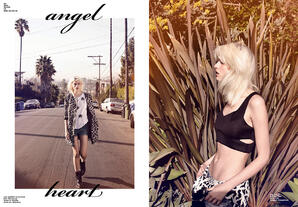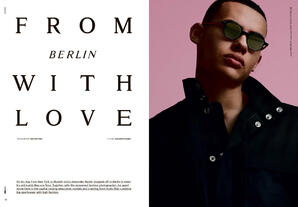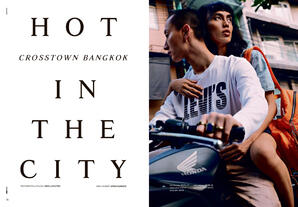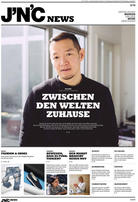 From the GOOD STUFF Interviews from J'N'C Magazine N°69 / 3-2017, Interviews: Cloat Gerold & Thorsten Osterberger
From the GOOD STUFF Interviews from J'N'C Magazine N°69 / 3-2017, Interviews: Cloat Gerold & Thorsten Osterberger
Martiene Raven is the founder of Rabenmütter, an online trend guide on brands with a conscience.
What does it take for a product to be called a timeless classic?
Funnily enough a timeless classic needs time. It has to be able to stand the test of time. Classics mostly derive from a deeper need, an anti-movement, influenced by economic change or the urge to create a better solution. Coco Chanel refused to wear the tightfitting dresses of the late 19th century and created her outfit from a men’s shirt and trousers. Comfortable and practical clothing fitted the era of the early 20th century perfectly. History and heritage are what often makes a piece a timeless classic. There are more modern classics too, of course. For example: Strongly branded by Adidas as “Forever a classic” and emotionally influenced by 80s pop culture, Superstar Originals are very much defining the street style image once again.
Frances Corner, head of the London College of Fashion asks an interesting question in the book “Why Fashion Matters”: “If all art was once contemporary, were all clothes once fashionable?”
As a trendcaster and creative director where exactly are you looking for new developments?
In general I read a lot of reports and articles on lifestyle and fashion. Social media is also an important source and I try to keep a rough overview of global or local developments in architecture, technology, politics or society itself. Visiting events, expositions and other cities are important as well.
More in-depth research on specific topics depends on the projects I work on. Mast-Jägermeister for example needs to be one step ahead of where the consumer is going. For one of their emerging markets, Paris, I researched and translated relevant urban insights to give them a reliable base they can proceed on for the next years.
For Philips I did an extensive style segmentation and developed a range of male personas for a shaving and grooming app they developed.
Three years ago I founded Rabenmütter, a trend and style guide on luxury fashion with a conscience for women. Keeping track of insights and new trends in sustainable fashion is part of my daily routine. By now I have collected and curated over 80 European sustainable labels.
"Sustainable fashion will no longer be a niche, but a longterm change in the fashion industry."
Do you think you can immediately spot what will become a “timeless classic”, even if the product is brand new on the market?
I don’t think so. As said, a “timeless classic” needs time to become a classic. Macro trends move and develop at a slower pace. It is often a micro trend that can grow into a “timeless” classic. But it needs its cultural, time-related story to grow into a “classic”.
Slogans like “slow fashion”, “less is more” and “stuffocation” are trending right now. Can you tell if this development will be catching on fashion-wise?
Yes, I think it will, but it’s still hard to predict how deep it will enter the DNA of fashion in the future and how long will it take. There are interesting shifts happening top down though. Kering for example, a global luxury group, has its strategy focussed on sustainability (and on women) or Livia Firth’s (EcoAge) Green Carpet Challenge.
The term sustainability or “eco” will more or less disappear, the essence, CSR and a certain transparency will remain and become a more integrated part of the fashion industry. Fuelled by changing legislation and the rising demand of upcoming generations for a more transparent, ethical and environmentally friendly way of sourcing, producing and distributing, companies have to change their business strategy to make the shift.
Do you think durability and timeless design will be more important in a future that is focusing increasingly on sustainability?
Absolutely. Some designers are downscaling the number of their shows annually and I know several designers who are choosing to design and create pieces that last more than one season or to produce made-by-order only. Sustainability will become a more integral part of our society, just like the level of safety we have right now in comparison to, let’s say in the early 20th century. The question is how willing consumers, companies and governmental institutions are to change and
adapt.
Which trend surprised you most lately?
I am not particularly interested in short-term seasonal trends. There are so many, spread over different generations and sub cultures. But I’m pleasantly surprised to see the rise of recycled swimwear over the last year. Several brands like Margaret & Hermione from Austria, TwoThirds and AllSisters from Spain, MyMarini from Germany and Whip Appeal of Sweden are doing a tremendous job by reusing and upcycling materials like old fishing nets and nylon waste into beautiful swimwear collections.
In about a decade, what trends do you think will remain or be repeated and what new developments can we expect?
The pioneers in bio couture, fash tech and circular economy are working on revolutionary developments and are already collaborating with big companies from the textile and fashion industry. The use of bio waste, like yarns made of oranges, invisible wires in garments, which will change our perspective of textiles and our skin. I definitely see those innovations entering the consumer market within five years, in the field of health or safety.
The urge to wear more ethically and environmentally friendly clothes and accessories will grow as well. Sustainable fashion will not be a niche, but a long-term change in the fashion industry.
Please name three timeless classics everybody should have in his/her wardrobe (and why).
I am not the one to tell others what they should have in their wardrobe. The general impression of every average major shopping street is already more of the same. I can only encourage you to wear what you like in the first place.
Personally I love beautifully tailor-made classic pieces, like a slim white shirt, dark pencil skirt or dress, made of high quality materials.
Please name three very trendy products you are glad of having hung onto over the years (and why)?
Scanning through my closet I think I don’t have any. I rarely buy something new. My wardrobe mainly exists of second hand and vintage pieces, collected over the years. When I buy something new, it has to be high quality, long-lasting and sustainable, or as I like to say it: with a conscience.
What’s your personal favourite “timeless classic” (and why)?
That’s an easy one! I can mention more than one. The definition of timeless has to do with the story behind each piece. And of course it has to have a nice fit and good quality. I cherish my red woollen coat from Agnes B. It actually got a hole in the lining, but a few months ago I repaired it during a test session with Golden Joinery. Working with golden threads and small pieces of fabric, based on the old Japanese tradition Kintsugi, made this coat even more precious to me.
Knowing the story of a piece, how it’s made and by whom, is what counts. What you wear is how you feel.








